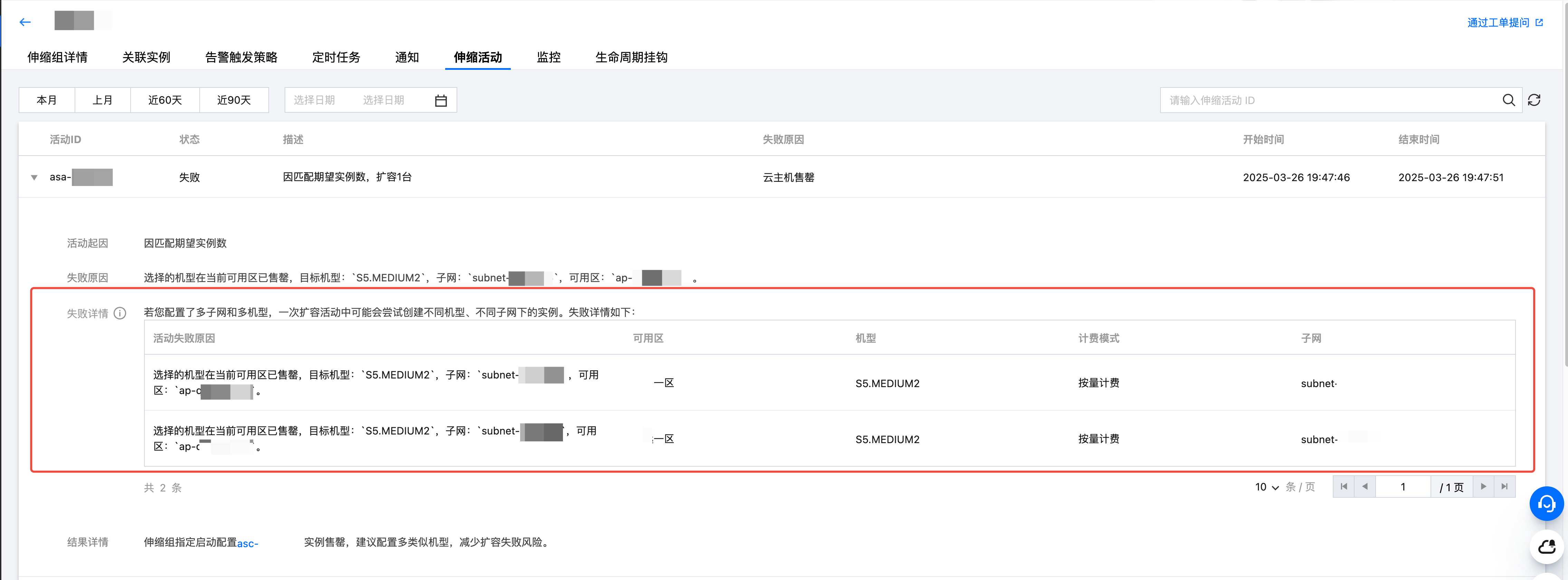伸缩活动失败
最后更新时间:2025-04-03 11:32:54
现象描述
执行伸缩活动时,可能会有一些原因导致活动失败,需要及时关注并处理以确保伸缩活动正常进行。
问题分析
查看原因说明
腾讯云 AS 提供了业界最智能的查看伸缩组活动失败原因方式,您可通过执行以下步骤查看伸缩活动失败的详细信息:
1. 单击 伸缩组列表 中伸缩活动失败的伸缩组 ID。
2. 在该伸缩组详情页,选择伸缩活动即可查看活动信息。如下图所示:


根据提示执行对应操作
您可根据伸缩活动失败原因执行相应操作,常见的伸缩活动失败原因如下。
伸缩活动失败原因
造成伸缩活动失败的原因可分为以下几类:
云服务器相关
镜像相关
网络相关
云硬盘相关
负载均衡相关
其它
故障处理
云服务器相关
1. 云服务器售罄
故障原因:指定资源库存不足。
处理方法:可在启动配置中配置多机型,视情况选择其他实例规格或者可用区。
2. 云服务器机型在当前可用区无效
3. 云服务器与云硬盘搭配无效
故障原因:当前系统盘类型不支持该机型实例。
处理方法:请检查伸缩配置,修改系统盘类型,建议选择高性能云盘/SSD云盘。
4. 云服务器购买配额不足
故障原因:每个用户都有 CVM 的购买配额,按量计费 CVM 的默认配额 请参见 购买按量计费 CVM 实例限制。
如果您超过了这个配额,AS 就会无法开出机器。
处理方法:减少扩容子机数量,或通过 提交工单 申请提高配额。
5. 云服务器机型不存在
故障原因:您启动配置里定义的机型不正确或已下架。
处理方法:请更换对应启动配置。
镜像相关
1. 镜像不存在
故障原因:镜像可能已经不存在或失效。
处理方法:请在启动配置中检查相关配置。
2. 镜像超过系统盘容量
故障原因:系统盘容量小于镜像文件大小。
处理方法:请检查启动配置,增大系统盘容量或者使用占用空间更小的镜像。
网络相关
1. 仅支持私有网络
故障原因:在启动配置中选定了仅支持私有网络(VPC)的机型。
处理方法:请勿在基础网络下使用该机型,在启动配置中取消选定该种机型。
2. VPC 子网内 IP 数量少于待扩容实例数量
故障原因:VPC 子网内 IP 数受限。
处理方法:新建子网,扩大其子网的网段范围(CIDR)。
云硬盘相关问题
1. 云盘售罄
故障原因:指定资源库存不足。
处理方法:可以启动配置中配置默认云盘功能。
2. 云服务器与云硬盘搭配无效
故障原因:当前系统盘类型不支持该机型实例。
处理方法:请检查伸缩配置,修改系统盘类型,建议选择高性能云盘/SSD 云盘。
负载均衡相关问题
1. 负载均衡不存在
故障原因:负载均衡可能已经不存在或失效。请在负载均衡中检查相关配置。
处理方法:请确保伸缩组关联的负载均衡实例处于正常工作的状态。
2. 监听器不存在
故障原因:负载均衡器中的监听器可能已经不存在或失效。请在负载均衡中检查相关配置。
处理方法:请确保伸缩组关联的负载均衡实例处于正常工作的状态。
3. 转发路径不存在
故障原因:负载均衡器中监听器转发至指定域名/URL 路径,您所创建的域名/URL 路径可能已经不存在或失效。请在负载均衡中检查相关配置。
处理方法:请确保伸缩组关联的负载均衡处于正常工作的状态。
4. 指定的负载均衡器繁忙
故障原因:负载均衡器任务进行中。
处理方法:建议在伸缩组活动时减少手动操作,避免操作互斥。
其它问题
生命周期动作的结果为放弃
故障原因:伸缩组配置了扩容类型的生命周期挂钩,当伸缩组扩容时,生命周期挂钩被触发,并且生命周期挂钩最终的执行结果为拒绝,导致扩容伸缩活动回滚,扩容出来的实例被释放。
处理方法:请检查生命周期挂钩的执行策略。
文档反馈

